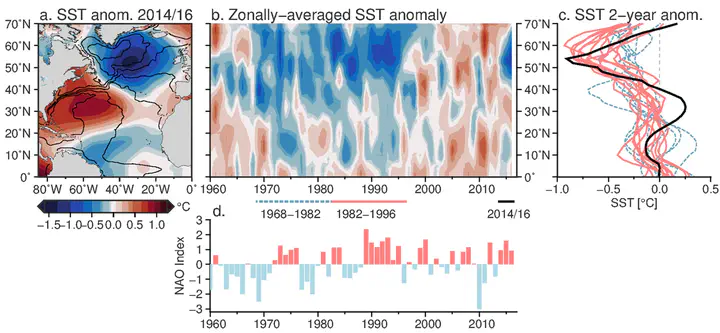Emerging negative Atlantic Multidecadal Oscillation index in spite of warm subtropics
 Sea surface temperature anomalies and evolution. (a) SST (°C) from the ERSST dataset for the period July 2014–June 2016 are plotted relative to the average over July 2004–June 2012. The map was created using Generic Mapping Toolbox v5.2.1 (gmt.soest.hawaii.edu/). (b) Temporal evolution of the zonally-averaged SST as a function of latitude. Both panels show that the recent period has a cold anomaly in the subpolar gyre, but also a warm anomaly in the subtropics. (c) Line plots of the zonally-averaged SSTs, where each line represents an average of 2-years. The periods included are the early part of the last cold AMO period (1963–1973, blue) and the late part (1973–1996, red). Black shows the profile for the 2 year period: July 2014–June 2016. (d) NAO index where the bar for 2015 represents the December 2015–February 2016 period.
Sea surface temperature anomalies and evolution. (a) SST (°C) from the ERSST dataset for the period July 2014–June 2016 are plotted relative to the average over July 2004–June 2012. The map was created using Generic Mapping Toolbox v5.2.1 (gmt.soest.hawaii.edu/). (b) Temporal evolution of the zonally-averaged SST as a function of latitude. Both panels show that the recent period has a cold anomaly in the subpolar gyre, but also a warm anomaly in the subtropics. (c) Line plots of the zonally-averaged SSTs, where each line represents an average of 2-years. The periods included are the early part of the last cold AMO period (1963–1973, blue) and the late part (1973–1996, red). Black shows the profile for the 2 year period: July 2014–June 2016. (d) NAO index where the bar for 2015 represents the December 2015–February 2016 period.Abstract
Sea surface temperatures in the northern North Atlantic have shown a marked decrease over the past several years. The sea surface in the subpolar gyre is now as cold as it was during the last cold phase of the Atlantic Multidecadal Oscillation index in the 1990s. This climate index is associated with shifts in hurricane activity, rainfall patterns and intensity, and changes in fish populations. However, unlike the last cold period in the Atlantic, the spatial pattern of sea surface temperature anomalies in the Atlantic is not uniformly cool, but instead has anomalously cold temperatures in the subpolar gyre, warm temperatures in the subtropics and cool anomalies over the tropics. The tripole pattern of anomalies has increased the subpolar to subtropical meridional gradient in SSTs, which are not represented by the AMO index value, but which may lead to increased atmospheric baroclinicity and storminess. Here we show that the recent Atlantic cooling is likely to persist, as predicted by a statistical forecast of subsurface ocean temperatures and consistent with the irreversible nature of watermass changes involved in the recent cooling of the subpolar gyre.